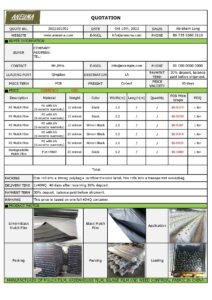In the dynamic landscape of modern agriculture, the pursuit of sustainable and efficient crop management practices is of paramount importance. Integrated Pest Management (IPM) has emerged as a holistic approach that harmonizes various strategies to effectively manage pests while minimizing the ecological footprint of farming. One innovative and impactful component of IPM is the integration of mulch film, a versatile agricultural tool, into pest management strategies. In this comprehensive guide, we delve into the synergistic relationship between IPM and mulch film, exploring its multifaceted benefits, practical applications, and the transformative potential it holds for sustainable crop protection.
Understanding Integrated Pest Management (IPM)
Integrated Pest Management (IPM) is a proactive and eco-friendly approach to pest control that aims to prevent, suppress, or manage pest populations while ensuring minimal impact on the environment, human health, and non-target organisms. Unlike traditional pest control methods that rely heavily on chemical interventions, IPM emphasizes a holistic and multifaceted approach that considers biological, cultural, physical, and chemical strategies in tandem.
The Role of Mulch Film in IPM
Mulch film, a thin layer of material placed on the soil surface around plants, offers a range of benefits beyond weed suppression and moisture conservation. When strategically integrated into IPM strategies, mulch film becomes a valuable tool that enhances crop protection, minimizes pest pressures, and promotes sustainable agricultural practices. Let’s delve into the ways mulch film contributes to effective IPM:
1. Mechanical Barrier Against Pests
Mulch film acts as a physical barrier that obstructs the movement of crawling insects and pests from the soil to the plant. This barrier effect helps prevent soil-borne pests, such as root-feeding nematodes, from gaining access to plant roots, reducing their ability to cause damage and infestations.
2. Reduced Weed Habitat
Weeds can serve as hosts for pest insects, providing them with a conducive environment to thrive. Mulch film suppresses weed growth, limiting the availability of alternate hosts for pests and disrupting their lifecycle. This indirectly reduces pest populations and their potential impact on crops.
3. Microclimate Modification
Mulch film influences the microclimate around plants by moderating soil temperature and moisture levels. This controlled environment can deter certain pests, as it may become less favorable for their development and reproduction. For instance, mulch film can deter soil-dwelling pests that thrive in warm and humid conditions.
4. Beneficial Insect Promotion
IPM emphasizes the role of beneficial insects in naturally controlling pest populations. Mulch film can create a refuge for these beneficial insects, offering shelter and a suitable environment for them to thrive. Predatory insects, such as ladybugs and parasitic wasps, find refuge in the mulch layer and contribute to pest suppression.
5. Reduced Chemical Dependency
By creating an environment that is less conducive to pest proliferation, mulch film can help reduce the reliance on chemical pesticides. This aligns with the core principle of IPM, which seeks to minimize the use of chemicals and prioritize environmentally friendly solutions.
Practical Applications of Mulch Film in IPM
The integration of mulch film into IPM strategies involves careful planning, implementation, and monitoring. Here are some practical applications that highlight the versatility of mulch film in pest management:
1. Mulch Film Selection
Choose a mulch film color that aligns with your IPM goals. For instance, reflective mulch films can repel certain insects, while opaque films can create a dark environment that discourages weed growth and pest activity.
2. Timing and Installation
Timing is crucial when installing mulch film. Consider the lifecycle of target pests and choose installation dates that disrupt their development. Securely anchor the mulch film to prevent pests from burrowing underneath.
3. Mulch Film Types
Different types of mulch films offer varying benefits. Biodegradable films break down over time, releasing organic matter that can enhance soil health and attract beneficial organisms. Plastic films can be reused and offer longer-term physical protection.
4. Companion Planting
Strategic companion planting, along with mulch film, can enhance IPM efforts. Certain plants have natural pest-repellent properties and can be intercropped with your main crop to create a pest-discouraging environment.
5. Monitoring and Adaptation
Regular monitoring is essential to assess the effectiveness of mulch film integration in IPM. Observe pest populations, crop health, and beneficial insect activity. Based on observations, adjust mulch film types, installation methods, or companion planting strategies as needed.
Challenges and Considerations
While mulch film integration offers numerous benefits, there are challenges and considerations to keep in mind:
- Moisture Management: Improper moisture regulation under mulch film can create conditions conducive to disease development. Proper irrigation practices are crucial.
- Microbial Activity: Biodegradable mulch films can attract soil microbes, which may influence pest and disease dynamics. Balancing microbial activity is essential.
- Compatibility: Some crops may have specific requirements or sensitivities to mulch film. Conduct thorough research to ensure compatibility before implementation.
Conclusion: A Sustainable Path Forward
The marriage of Integrated Pest Management (IPM) principles and mulch film technology represents a harmonious synergy that propels modern agriculture toward sustainable and resilient practices. By strategically harnessing the benefits of mulch film – from mechanical pest exclusion to microclimate modification – growers can embrace a comprehensive approach that minimizes chemical dependency, enhances crop health, and fosters environmental stewardship. As the agriculture industry continues to evolve, the integration of mulch film into IPM strategies stands as a shining example of innovation that empowers farmers to cultivate abundance while safeguarding the delicate balance of our ecosystems. Through thoughtful implementation and continuous adaptation, the journey toward sustainable crop protection is illuminated by the dynamic partnership between Integrated Pest Management and the versatile power of mulch film.

